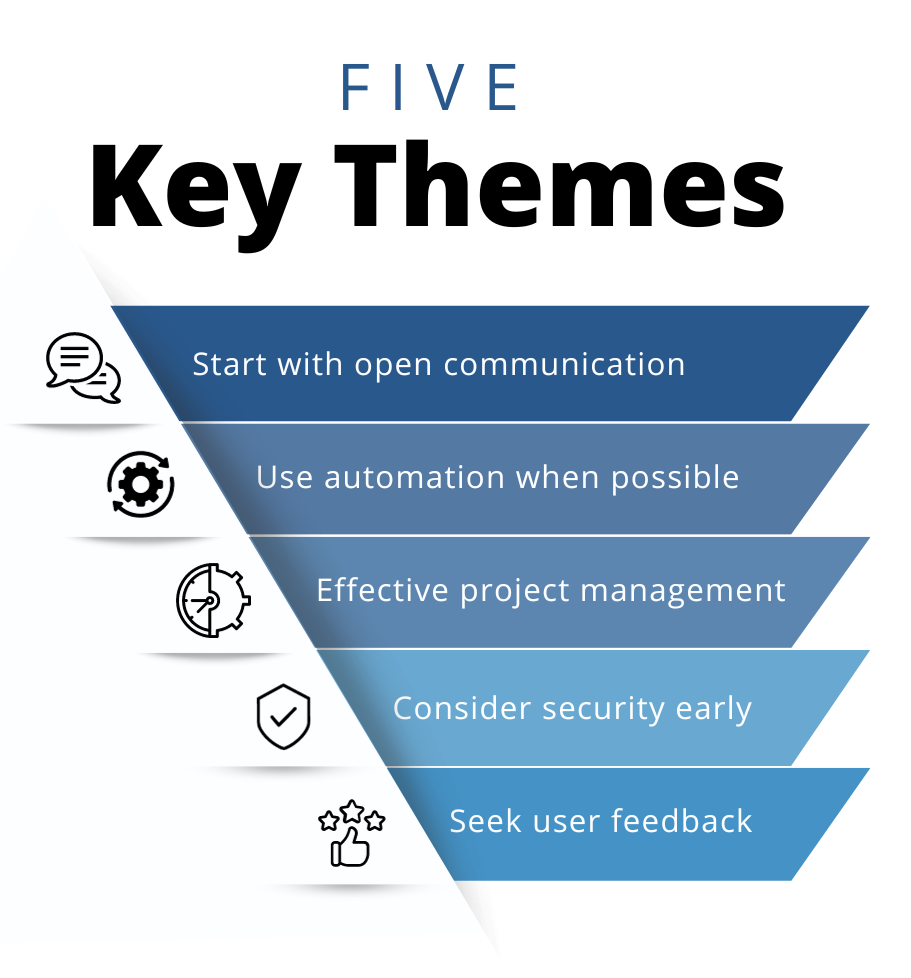October 19, 2023
Tips for Transitioning from Legacy Systems to Modern Technology Solutions
Transitioning from legacy systems to new technology solutions can be a major undertaking. Without an effective project management process, organizations may not have a clear vision for the return on investment (ROI) they hope to achieve from their implementation.
Our Experience
A lot organizations are working on moving away from legacy systems into new on-premises or cloud-based solutions. Here are a few general themes that have led to successful implementations:
The first theme is a communication to enhance employee buy-in. Software can only be as effective as the people who use it, and resistance to change is one of the key challenges that could negatively impact a successful implementation, if there is no buy-in. This includes:
- Communicating to employees ahead of time why it is important to implement a new system (e.g. to stay ahead of or keep pace with the competition),
- Obtaining feedback on the features/capabilities they would like to see in the new system and expressing how important their role is in making the implementation a success, will result in employees feeling more invested in the new system.
The second theme is developing an effective training program. It’s imperative that the end users understand how to use the system. This will help them perform their roles effectively, minimizing any loss of productivity associated with the new implementation and improving job performance.
Lastly, a smooth and successful implementation requires project management to execute the detailed plan. A project plan is developed to ensure project scope and objectives, budget, and realistic implementation deadlines are defined and able to be met. In addition, consistent communication with the project team and stakeholders to maintain transparency about the project’s status so there are no surprises.
What are pain points that organizations have experienced during system implementations, both from the beginning and during the process?
The first thing that comes to mind is a flawed vendor selection process. Having a formal and structured vendor selection process to evaluate each vendor in a silo, and determine the vendor’s approach to achieve the end-users’ expected functionality and features. This process also avoids the possibility of investing in tools and features that are not actually needed to meet the objectives.
Second, data quality issues due to lack of data quality requirements. For example, if there are no validation rules to standardize data and cleanse it before it enters the new system, then the system will not work without correctly formatted data.
The third item is insufficient resources and capacity issues. Without adequate project staffing, tasks may be assigned to personnel that do not have the right skills to perform or carry out the task or ensure quality output and successful project outcome.
Employees and the Business
At what point is it reasonable or highly recommended for an organization to involve all the partners within the business that are going to be affected? From the start when you’re evaluating the needs, or after the vendor selection?
As previously mentioned, communication needs to start at the beginning of the process, specifically when the organization is defining the scope and objectives. As a result of the new system, new processes will be implemented and end users’ job roles will be impacted. Users can provide valuable input for the new system and when they know their feedback is considered, they are more likely to embrace the new system.
Data Migration
One of the pain points previously described was data quality. Is it better to move data manually or through a migration tool?
Using automated migration tools is the best recommendation, especially when there is a lot of data to move. The tools can take days to complete a process that would take weeks or months in a manual migration.
Migration tools require little to no human intervention, which minimizes human errors and the data’s integrity is preserved during migration. Even with great automation tools, the migration will be unsuccessful without documented quality requirements which include a data migration strategy.
Security
Something that often gets less attention is security. When should security be implemented in the process?
Security needs to be considered during the design and development phase. Companies should adopt a secure software development lifecycle (SSDLC) for in-house developed applications and to assess and/or test the security of externally developed applications. SSDLC provides the opportunity to remove more security vulnerabilities early in the development lifecycle. In addition, SSDLC supports regulatory compliance and security standards.
Not taking the right cybersecurity approach could potentially result in a data breach or fines and penalties for noncompliance.
Training
Having an effective training program is a common theme in successful implementations. How should organizations tackle an effective transition for end users to utilize the new system?
Training needs to be developed alongside user acceptance testing (UAT) in order to minimize the risk of needing to rework training materials. Training sessions should be mandatory for all users and encouraged for non-users. Question-and-answer (Q&A) sessions should be available at the end of each training session so that users can ask questions to address doubts about the new system.
Once employees are comfortable and confident using the new system, productivity and efficiency will improve. Post-implementation support should also be provided to users.
Go-Live
What are some of the consequences you have seen when companies rush into go-live dates to meet deadlines or expectations of the business? And what measures can be taken to mitigate these risks?
Some consequences may include burnout due to the stress of being overworked and decreased buy-in because the project has become more important than the employees. Employees may become frustrated and disengaged from contributing to achieving the implementation objectives.
To mitigate these risks and others, the most important indicator of a successful implementation is effective project management. Project management includes setting a clear project plan to coordinate all the activities and resources needed to meet deadlines and achieve successful project outcomes.
Conclusion
Here is some final advice for organizations looking to move on from legacy architecture:
It is important to reiterate the value of communication to obtain employee buy-in. Implementing a new system is a significant task that requires detailed planning to ensure smooth execution.
Resistance is inevitable, but communicating early and often throughout the project will help reduce the amount of resistance to execute successful implementations.
If your organization is considering implementing a new system, and you would like further guidance on creating a successful transition, reach out to our team today.




